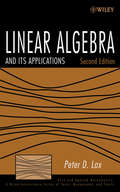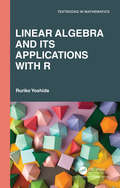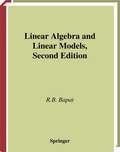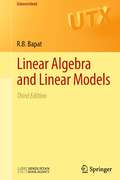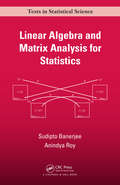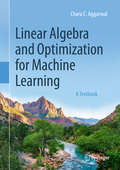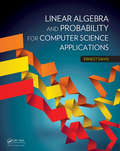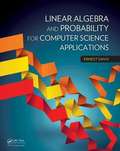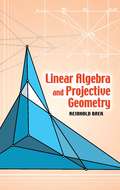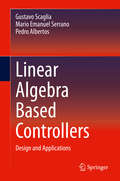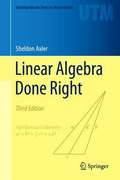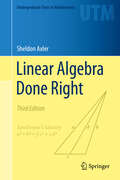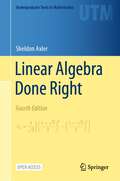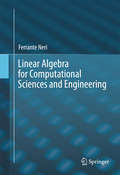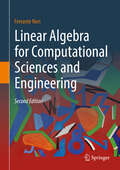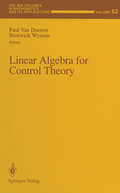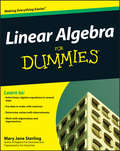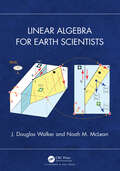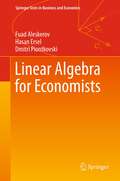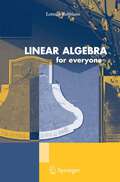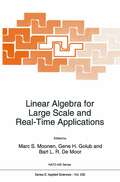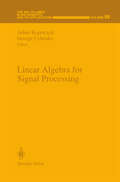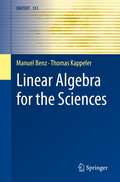- Table View
- List View
Linear Algebra and Its Applications (Pure and Applied Mathematics: A Wiley Series of Texts, Monographs and Tracts #97)
by Peter D. LaxPraise for the First Edition ". . .recommended for the teacher and researcher as well as for graduate students. In fact, [it] has a place on every mathematician's bookshelf." -American Mathematical Monthly Linear Algebra and Its Applications, Second Edition presents linear algebra as the theory and practice of linear spaces and linear maps with a unique focus on the analytical aspects as well as the numerous applications of the subject. In addition to thorough coverage of linear equations, matrices, vector spaces, game theory, and numerical analysis, the Second Edition features student-friendly additions that enhance the book's accessibility, including expanded topical coverage in the early chapters, additional exercises, and solutions to selected problems. Beginning chapters are devoted to the abstract structure of finite dimensional vector spaces, and subsequent chapters address convexity and the duality theorem as well as describe the basics of normed linear spaces and linear maps between normed spaces. Further updates and revisions have been included to reflect the most up-to-date coverage of the topic, including: The QR algorithm for finding the eigenvalues of a self-adjoint matrix The Householder algorithm for turning self-adjoint matrices into tridiagonal form The compactness of the unit ball as a criterion of finite dimensionality of a normed linear space Additionally, eight new appendices have been added and cover topics such as: the Fast Fourier Transform; the spectral radius theorem; the Lorentz group; the compactness criterion for finite dimensionality; the characterization of commentators; proof of Liapunov's stability criterion; the construction of the Jordan Canonical form of matrices; and Carl Pearcy's elegant proof of Halmos' conjecture about the numerical range of matrices. Clear, concise, and superbly organized, Linear Algebra and Its Applications, Second Edition serves as an excellent text for advanced undergraduate- and graduate-level courses in linear algebra. Its comprehensive treatment of the subject also makes it an ideal reference or self-study for industry professionals.
Linear Algebra and Its Applications with R (Textbooks in Mathematics)
by Ruriko YoshidaThe book developed from the need to teach a linear algebra course to students focused on data science and bioinformatics programs. These students tend not to realize the importance of linear algebra in applied sciences since traditional linear algebra courses tend to cover mathematical contexts but not the computational aspect of linear algebra or its applications to data science and bioinformatics. The author presents the topics in a traditional course yet offers lectures as well as lab exercises on simulated and empirical data sets. This textbook provides students a theoretical basis which can then be applied to the practical R and Python problems, providing the tools needed for real-world applications. Each section starts with working examples to demonstrate how tools from linear algebra can help solve problems in applied science. These exercises start from easy computations, such as computing determinants of matrices, to practical applications on simulated and empirical data sets with R so that students learn how to get started with R along with computational examples in each section and then they learn how to apply what they learn to problems in applied sciences. This book is designed from first principles to demonstrate the importance of linear algebra through working computational examples with R and python including tutorials on how to install R in the Appendix. If a student has never seen R, they can get started without any additional help. Since Python is one of the most popular languages in data science, optimization, and computer science, code supplements are available for students who feel more comfortable with Python. R is used primarily for computational examples to develop student’s practical computational skills. Table of Contents PrefaceList of FiguresList of Tables1. Systems of Linear Equations and Matrices2. Matrix Arithmetic3. Deteminants4. Vector Spaces5. Inner Product Space6. Eigen values and Eigen vectors7. Linear Regression8. Linear ProgrammingNetwork AnalysisAppendicesA) Introduction to RStudio via Amazon Web Service (AWS) B) Introduction to R Bibliography Index BiographyDr. Ruriko Yoshida is an Associate Professor of Operations Research at the Naval Postgraduate School. She received her Ph.D. in Mathematics from the University of California, Davis. Her research topics cover a wide variety of areas: applications of algebraic combinatorics to statistical problems such as statistical learning on non-Euclidean spaces, sensor networks, phylogenetics, and phylogenomics. She teaches courses in statistics, stochastic models, probability, and data science.
Linear Algebra and Its Applications with R (Textbooks in Mathematics)
by Ruriko YoshidaThe book developed from the need to teach a linear algebra course to students focused on data science and bioinformatics programs. These students tend not to realize the importance of linear algebra in applied sciences since traditional linear algebra courses tend to cover mathematical contexts but not the computational aspect of linear algebra or its applications to data science and bioinformatics. The author presents the topics in a traditional course yet offers lectures as well as lab exercises on simulated and empirical data sets. This textbook provides students a theoretical basis which can then be applied to the practical R and Python problems, providing the tools needed for real-world applications. Each section starts with working examples to demonstrate how tools from linear algebra can help solve problems in applied science. These exercises start from easy computations, such as computing determinants of matrices, to practical applications on simulated and empirical data sets with R so that students learn how to get started with R along with computational examples in each section and then they learn how to apply what they learn to problems in applied sciences. This book is designed from first principles to demonstrate the importance of linear algebra through working computational examples with R and python including tutorials on how to install R in the Appendix. If a student has never seen R, they can get started without any additional help. Since Python is one of the most popular languages in data science, optimization, and computer science, code supplements are available for students who feel more comfortable with Python. R is used primarily for computational examples to develop student’s practical computational skills. Table of Contents PrefaceList of FiguresList of Tables1. Systems of Linear Equations and Matrices2. Matrix Arithmetic3. Deteminants4. Vector Spaces5. Inner Product Space6. Eigen values and Eigen vectors7. Linear Regression8. Linear ProgrammingNetwork AnalysisAppendicesA) Introduction to RStudio via Amazon Web Service (AWS) B) Introduction to R Bibliography Index BiographyDr. Ruriko Yoshida is an Associate Professor of Operations Research at the Naval Postgraduate School. She received her Ph.D. in Mathematics from the University of California, Davis. Her research topics cover a wide variety of areas: applications of algebraic combinatorics to statistical problems such as statistical learning on non-Euclidean spaces, sensor networks, phylogenetics, and phylogenomics. She teaches courses in statistics, stochastic models, probability, and data science.
Linear Algebra and Linear Models (Universitext)
by Ravindra B. BapatThis book provides a rigorous introduction to the basic aspects of the theory of linear estimation and hypothesis testing, covering the necessary prerequisites in matrices, multivariate normal distribution and distributions of quadratic forms along the way. It will appeal to advanced undergraduate and first-year graduate students, research mathematicians and statisticians.
Linear Algebra and Linear Models (Universitext)
by Ravindra B. BapatLinear Algebra and Linear Models comprises a concise and rigorous introduction to linear algebra required for statistics followed by the basic aspects of the theory of linear estimation and hypothesis testing. The emphasis is on the approach using generalized inverses. Topics such as the multivariate normal distribution and distribution of quadratic forms are included.For this third edition, the material has been reorganised to develop the linear algebra in the first six chapters, to serve as a first course on linear algebra that is especially suitable for students of statistics or for those looking for a matrix theoretic approach to the subject. Other key features include: coverage of topics such as rank additivity, inequalities for eigenvalues and singular values; a new chapter on linear mixed models; over seventy additional problems on rank: the matrix rank is an important and rich topic with connections to many aspects of linear algebra such as generalized inverses, idempotent matrices and partitioned matrices.This text is aimed primarily at advanced undergraduate and first-year graduate students taking courses in linear algebra, linear models, multivariate analysis and design of experiments. A wealth of exercises, complete with hints and solutions, help to consolidate understanding. Researchers in mathematics and statistics will also find the book a useful source of results and problems.
Linear Algebra and Matrix Analysis for Statistics (Chapman And Hall/crc Texts In Statistical Science Ser.)
by Sudipto BanerjeeLinear Algebra and Matrix Analysis for Statistics offers a gradual exposition to linear algebra without sacrificing the rigor of the subject. It presents both the vector space approach and the canonical forms in matrix theory. The book is as self-contained as possible, assuming no prior knowledge of linear algebra.The authors first address the rudi
Linear Algebra and Optimization for Machine Learning: A Textbook
by Charu C. AggarwalThis textbook introduces linear algebra and optimization in the context of machine learning. Examples and exercises are provided throughout this text book together with access to a solution’s manual. This textbook targets graduate level students and professors in computer science, mathematics and data science. Advanced undergraduate students can also use this textbook. The chapters for this textbook are organized as follows:1. Linear algebra and its applications: The chapters focus on the basics of linear algebra together with their common applications to singular value decomposition, matrix factorization, similarity matrices (kernel methods), and graph analysis. Numerous machine learning applications have been used as examples, such as spectral clustering, kernel-based classification, and outlier detection. The tight integration of linear algebra methods with examples from machine learning differentiates this book from generic volumes on linear algebra. The focus is clearly on the most relevant aspects of linear algebra for machine learning and to teach readers how to apply these concepts.2. Optimization and its applications: Much of machine learning is posed as an optimization problem in which we try to maximize the accuracy of regression and classification models. The “parent problem” of optimization-centric machine learning is least-squares regression. Interestingly, this problem arises in both linear algebra and optimization, and is one of the key connecting problems of the two fields. Least-squares regression is also the starting point for support vector machines, logistic regression, and recommender systems. Furthermore, the methods for dimensionality reduction and matrix factorization also require the development of optimization methods. A general view of optimization in computational graphs is discussed together with its applications to back propagation in neural networks. A frequent challenge faced by beginners in machine learning is the extensive background required in linear algebra and optimization. One problem is that the existing linear algebra and optimization courses are not specific to machine learning; therefore, one would typically have to complete more course material than is necessary to pick up machine learning. Furthermore, certain types of ideas and tricks from optimization and linear algebra recur more frequently in machine learning than other application-centric settings. Therefore, there is significant value in developing a view of linear algebra and optimization that is better suited to the specific perspective of machine learning.
Linear Algebra and Probability for Computer Science Applications
by Ernest DavisBased on the author's course at NYU, Linear Algebra and Probability for Computer Science Applications gives an introduction to two mathematical fields that are fundamental in many areas of computer science. The course and the text are addressed to students with a very weak mathematical background. Most of the chapters discuss relevant MATLAB functi
Linear Algebra and Probability for Computer Science Applications (PDF)
by Ernest DavisBased on the author's course at NYU, Linear Algebra and Probability for Computer Science Applicationsgives an introduction to two mathematical fields that are fundamental in many areas of computer science. The course and the text are addressed to students with a very weak mathematical background. Most of the chapters discuss relevant MATLAB#65533;functions and features and give sample assignments in MATLAB; the author's website provides the MATLAB code from the book. After an introductory chapter on MATLAB, the text is divided into two sections. The section on linear algebra gives an introduction to the theory of vectors, matrices, and linear transformations over the reals. It includes an extensive discussion on Gaussian elimination, geometric applications, and change of basis. It also introduces the issues of numerical stability and round-off error, the discrete Fourier transform, and singular value decomposition. The section on probability presents an introduction to the basic theory of probability and numerical random variables; later chapters discuss Markov models, Monte Carlo methods, information theory, and basic statistical techniques. The focus throughout is on topics and examples that are particularly relevant to computer science applications; for example, there is an extensive discussion on the use of hidden Markov models for tagging text and a discussion of the Zipf (inverse power law) distribution. Examples and Programming Assignments The examples and programming assignments focus on computer science applications. The applications covered are drawn from a range of computer science areas, including computer graphics, computer vision, robotics, natural language processing, web search, machine learning, statistical analysis, game playing, graph theory, scientific computing, decision theory, coding, cryptography, network analysis, data compression, and signal processing. Homework ProblemsComprehensive problem sections include traditional calculation exercises, thought problems such as proofs, and programming assignments that involve creating MATLAB functions.
Linear Algebra and Projective Geometry
by Reinhold BaerGeared toward upper-level undergraduates and graduate students, this text establishes that projective geometry and linear algebra are essentially identical. The supporting evidence consists of theorems offering an algebraic demonstration of certain geometric concepts. These focus on the representation of projective geometries by linear manifolds, of projectivities by semilinear transformations, of collineations by linear transformations, and of dualities by semilinear forms. These theorems lead to a reconstruction of the geometry that constituted the discussion's starting point, within algebraic structures such as the endomorphism ring of the underlying manifold or the full linear group.Restricted to topics of an algebraic nature, the text shows how far purely algebraic methods may extend. It assumes only a familiarity with the basic concepts and terms of algebra. The methods of transfinite set theory frequently recur, and for readers unfamiliar with this theory, the concepts and principles appear in a special appendix.
Linear Algebra Based Controllers: Design and Applications
by Gustavo Scaglia Mario Emanuel Serrano Pedro AlbertosThis book summarizes the application of linear algebra-based controllers (LABC) for trajectory tracking for practitioners and students across a range of engineering disciplines. It clarifies the necessary steps to apply this straight-forward technique to a non-linear multivariable system, dealing with continuous or discrete time models, and outlines the steps to implement such controllers. In this book, the authors present an approach of the trajectory tracking problem in systems with dead time and in the presence of additive uncertainties and environmental disturbances. Examples of applications of LABC to systems in real operating conditions (mobile robots, marine vessels, quadrotor and pvtol aircraft, chemical reactors and First Order Plus Dead Time systems) illustrate the controller design in such a way that the reader attains an understanding of LABC.
Linear Algebra Done Right (Undergraduate Texts In Mathematics Ser. (PDF))
by Sheldon AxlerThis best-selling textbook for a second course in linear algebra is aimed at undergrad math majors and graduate students. The novel approach taken here banishes determinants to the end of the book. The text focuses on the central goal of linear algebra: understanding the structure of linear operators on finite-dimensional vector spaces. The author has taken unusual care to motivate concepts and to simplify proofs. A variety of interesting exercises in each chapter helps students understand and manipulate the objects of linear algebra. The third edition contains major improvements and revisions throughout the book. More than 300 new exercises have been added since the previous edition. Many new examples have been added to illustrate the key ideas of linear algebra. New topics covered in the book include product spaces, quotient spaces, and dual spaces. Beautiful new formatting creates pages with an unusually pleasant appearance in both print and electronic versions. No prerequisites are assumed other than the usual demand for suitable mathematical maturity. Thus the text starts by discussing vector spaces, linear independence, span, basis, and dimension. The book then deals with linear maps, eigenvalues, and eigenvectors. Inner-product spaces are introduced, leading to the finite-dimensional spectral theorem and its consequences. Generalized eigenvectors are then used to provide insight into the structure of a linear operator.
Linear Algebra Done Right (Undergraduate Texts in Mathematics)
by Sheldon AxlerThis best-selling textbook for a second course in linear algebra is aimed at undergrad math majors and graduate students. The novel approach taken here banishes determinants to the end of the book. The text focuses on the central goal of linear algebra: understanding the structure of linear operators on finite-dimensional vector spaces. The author has taken unusual care to motivate concepts and to simplify proofs. A variety of interesting exercises in each chapter helps students understand and manipulate the objects of linear algebra.The third edition contains major improvements and revisions throughout the book. More than 300 new exercises have been added since the previous edition. Many new examples have been added to illustrate the key ideas of linear algebra. New topics covered in the book include product spaces, quotient spaces, and dual spaces. Beautiful new formatting creates pages with an unusually pleasant appearance in both print and electronic versions.No prerequisites are assumed other than the usual demand for suitable mathematical maturity. Thus the text starts by discussing vector spaces, linear independence, span, basis, and dimension. The book then deals with linear maps, eigenvalues, and eigenvectors. Inner-product spaces are introduced, leading to the finite-dimensional spectral theorem and its consequences. Generalized eigenvectors are then used to provide insight into the structure of a linear operator.
Linear Algebra Done Right (Undergraduate Texts in Mathematics)
by Sheldon AxlerNow available in Open Access, this best-selling textbook for a second course in linear algebra is aimed at undergraduate math majors and graduate students. The fourth edition gives an expanded treatment of the singular value decomposition and its consequences. It includes a new chapter on multilinear algebra, treating bilinear forms, quadratic forms, tensor products, and an approach to determinants via alternating multilinear forms. This new edition also increases the use of the minimal polynomial to provide cleaner proofs of multiple results. Also, over 250 new exercises have been added.The novel approach taken here banishes determinants to the end of the book. The text focuses on the central goal of linear algebra: understanding the structure of linear operators on finite-dimensional vector spaces. The author has taken unusual care to motivate concepts and simplify proofs. A variety of interesting exercises in each chapter helps students understand and manipulate the objects of linear algebra. Beautiful formatting creates pages with an unusually student-friendly appearance in both print and electronic versions. No prerequisites are assumed other than the usual demand for suitable mathematical maturity. The text starts by discussing vector spaces, linear independence, span, basis, and dimension. The book then deals with linear maps, eigenvalues, and eigenvectors. Inner-product spaces are introduced, leading to the finite-dimensional spectral theorem and its consequences. Generalized eigenvectors are then used to provide insight into the structure of a linear operator.From the reviews of previous editions:Altogether, the text is a didactic masterpiece. — zbMATHThe determinant-free proofs are elegant and intuitive. — American Mathematical MonthlyThe most original linear algebra book to appear in years, it certainly belongs in every undergraduate library — CHOICE
Linear Algebra for Computational Sciences and Engineering
by Ferrante NeriThis book presents the main concepts of linear algebra from the viewpoint of applied scientists such as computer scientists and engineers, without compromising on mathematical rigor. Based on the idea that computational scientists and engineers need, in both research and professional life, an understanding of theoretical concepts of mathematics in order to be able to propose research advances and innovative solutions, every concept is thoroughly introduced and is accompanied by its informal interpretation. Furthermore, most of the theorems included are first rigorously proved and then shown in practice by a numerical example. When appropriate, topics are presented also by means of pseudocodes, thus highlighting the computer implementation of algebraic theory.It is structured to be accessible to everybody, from students of pure mathematics who are approaching algebra for the first time to researchers and graduate students in applied sciences who need a theoretical manual of algebra to successfully perform their research. Most importantly, this book is designed to be ideal for both theoretical and practical minds and to offer to both alternative and complementary perspectives to study and understand linear algebra.
Linear Algebra for Computational Sciences and Engineering
by Ferrante NeriThis book presents the main concepts of linear algebra from the viewpoint of applied scientists such as computer scientists and engineers, without compromising on mathematical rigor. Based on the idea that computational scientists and engineers need, in both research and professional life, an understanding of theoretical concepts of mathematics in order to be able to propose research advances and innovative solutions, every concept is thoroughly introduced and is accompanied by its informal interpretation. Furthermore, most of the theorems included are first rigorously proved and then shown in practice by a numerical example. When appropriate, topics are presented also by means of pseudocodes, thus highlighting the computer implementation of algebraic theory.It is structured to be accessible to everybody, from students of pure mathematics who are approaching algebra for the first time to researchers and graduate students in applied sciences who need a theoretical manual of algebra to successfully perform their research. Most importantly, this book is designed to be ideal for both theoretical and practical minds and to offer to both alternative and complementary perspectives to study and understand linear algebra.
Linear Algebra for Control Theory (The IMA Volumes in Mathematics and its Applications #62)
by Paul Van Dooren Bostwick WymanDuring the past decade the interaction between control theory and linear algebra has been ever increasing, giving rise to new results in both areas. As a natural outflow of this research, this book presents information on this interdisciplinary area. The cross-fertilization between control and linear algebra can be found in subfields such as Numerical Linear Algebra, Canonical Forms, Ring-theoretic Methods, Matrix Theory, and Robust Control. This book's editors were challenged to present the latest results in these areas and to find points of common interest. This volume reflects very nicely the interaction: the range of topics seems very wide indeed, but the basic problems and techniques are always closely connected. And the common denominator in all of this is, of course, linear algebra.This book is suitable for both mathematicians and students.
Linear Algebra For Dummies
by Mary Jane SterlingLearn to: Solve linear algebra equations in several ways Put data in order with matrices Determine values with determinants Work with eigenvalues and eigenvectors Your hands-on guide to real-world applications of linear algebra Does linear algebra leave you feeling lost? No worries —this easy-to-follow guide explains the how and the why of solving linear algebra problems in plain English. From matrices to vector spaces to linear transformations, you'll understand the key concepts and see how they relate to everything from genetics to nutrition to spotted owl extinction. Line up the basics — discover several different approaches to organizing numbers and equations, and solve systems of equations algebraically or with matrices Relate vectors and linear transformations — link vectors and matrices with linear combinations and seek solutions of homogeneous systems Evaluate determinants — see how to perform the determinant function on different sizes of matrices and take advantage of Cramer's rule Hone your skills with vector spaces — determine the properties of vector spaces and their subspaces and see linear transformation in action Tackle eigenvalues and eigenvectors — define and solve for eigenvalues and eigenvectors and understand how they interact with specific matrices Open the book and find: Theoretical and practical ways of solving linear algebra problems Definitions of terms throughout and in the glossary New ways of looking at operations How linear algebra ties together vectors, matrices, determinants, and linear transformations Ten common mathematical representations of Greek letters Real-world applications of matrices and determinants
Linear Algebra for Earth Scientists
by J. Douglas Walker Noah M. McLeanLinear Algebra for Earth Scientists is written for undergraduate and graduate students in Earth and Environmental sciences. It is intended to give students enough background in linear algebra to work with systems of equations and data in geology, hydrology, geophysics, or whatever part of the Earth Sciences they engage with.The book does not presuppose any extensive prior knowledge of linear algebra. Instead, the book builds students up from a low base to a working understanding of the sub t that they can apply to their work, using many familiar examples in the geosciences.Features Suitable for students of Earth and Environmental Sciences Minimal prerequisites — written in a way that is accessible and engaging for those without a mathematical background All material presented with examples and applications to the Earth Sciences
Linear Algebra for Earth Scientists
by J. Douglas Walker Noah M. McLeanLinear Algebra for Earth Scientists is written for undergraduate and graduate students in Earth and Environmental sciences. It is intended to give students enough background in linear algebra to work with systems of equations and data in geology, hydrology, geophysics, or whatever part of the Earth Sciences they engage with.The book does not presuppose any extensive prior knowledge of linear algebra. Instead, the book builds students up from a low base to a working understanding of the sub t that they can apply to their work, using many familiar examples in the geosciences.Features Suitable for students of Earth and Environmental Sciences Minimal prerequisites — written in a way that is accessible and engaging for those without a mathematical background All material presented with examples and applications to the Earth Sciences
Linear Algebra for Economists (Springer Texts in Business and Economics)
by Fuad Aleskerov Hasan Ersel Dmitri PiontkovskiThis textbook introduces students of economics to the fundamental notions and instruments in linear algebra. Linearity is used as a first approximation to many problems that are studied in different branches of science, including economics and other social sciences. Linear algebra is also the most suitable to teach students what proofs are and how to prove a statement. The proofs that are given in the text are relatively easy to understand and also endow the student with different ways of thinking in making proofs. Theorems for which no proofs are given in the book are illustrated via figures and examples. All notions are illustrated appealing to geometric intuition. The book provides a variety of economic examples using linear algebraic tools. It mainly addresses students in economics who need to build up skills in understanding mathematical reasoning. Students in mathematics and informatics may also be interested in learning about the use of mathematics in economics.
Linear Algebra for Everyone
by Lorenzo RobbianoThis book provides students with the rudiments of Linear Algebra, a fundamental subject for students in all areas of science and technology. The book would also be good for statistics students studying linear algebra.It is the translation of a successful textbook currently being used in Italy. The author is a mathematician sensitive to the needs of a general audience. In addition to introducing fundamental ideas in Linear Algebra through a wide variety of interesting examples, the book also discusses topics not usually covered in an elementary text (e.g. the "cost" of operations, generalized inverses, approximate solutions). The challenge is to show why the "everyone" in the title can find Linear Algebra useful and easy to learn.The translation has been prepared by a native English speaking mathematician, Professor Anthony V. Geramita.
Linear Algebra for Large Scale and Real-Time Applications (NATO Science Series E: #232)
by M. S. Moonen Gene H. Golub B. L. De MoorProceedings of the NATO Advanced Study Institute, Leuven, Belgium, August 3-14, 1992
Linear Algebra for Signal Processing (The IMA Volumes in Mathematics and its Applications #69)
by Adam Bojanczyk George CybenkoSignal processing applications have burgeoned in the past decade. During the same time, signal processing techniques have matured rapidly and now include tools from many areas of mathematics, computer science, physics, and engineering. This trend will continue as many new signal processing applications are opening up in consumer products and communications systems. In particular, signal processing has been making increasingly sophisticated use of linear algebra on both theoretical and algorithmic fronts. This volume gives particular emphasis to exposing broader contexts of the signal processing problems so that the impact of algorithms and hardware can be better understood; it brings together the writings of signal processing engineers, computer engineers, and applied linear algebraists in an exchange of problems, theories, and techniques. This volume will be of interest to both applied mathematicians and engineers.
Linear Algebra for the Sciences (UNITEXT #151)
by Manuel Benz Thomas KappelerThis book is based on a course for first-semester science students, held by the second author at the University of Zurich several times. Its goal is threefold: to have students learn a minimal working knowledge of linear algebra, acquire some computational skills, and familiarize them with mathematical language to make mathematical literature more accessible. Therefore, we give precise definitions, introduce helpful notations, and state any results carefully worded. We provide no proofs of these results but typically illustrate them with numerous examples. Additionally, for better understanding, we often give supporting arguments for why they are valid.
